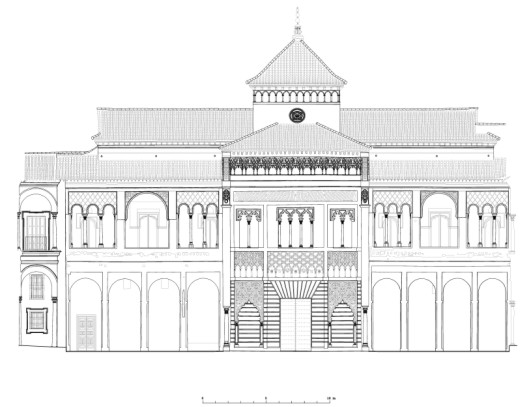call room "basilica" to the civil courts as we know it the whole palate of Medina Azahara, where rooms are large parallel vessels each consisting of five bays. The three plants are the basilica space itself, and are separated by two trussed arches extrados of three planes at the same height, and roofs covered by armor, these ships do not present the scaling characteristic of the Roman and early Christian basilicas, which allow high side lighting. The two extreme rooms, separated by one or three gates, are the same height, inspired, no doubt, in ships mosque. To the five ships, a large transept, also the same height and which serves as a porch. The extreme lateral sections of the ship become independent, forming an autonomous space that gives proper termination.
rooms such great decorative value, as we call "Living Rico" or Abd al-Rahman III, called Axarquia Majlis, or East Hall. Others, such as Dar al-Jund, or military house was very sober but full of architectural interest, as its side arches do not repeat a rhythm unit, but who are organizing a large central horseshoe arch piers, between two modules three arches columns identical to the entrance to the nave of the basilica room. This tripartite door module, of Byzantine origin, is characteristic of the Hispano-Umayyad architecture.
City of Medina Azahara Palatine, Córdoba (936-976) . Plan, elevation and cross sections of Hall Rico or Abdurrahman III (953-957) .
City of Medina Azahara Palatine, Córdoba (936-976). Hall Longitudinal section Rico or Abdurrahman III (953-957) .
 City of Medina Azahara Palatine, Córdoba (936-976). Hall Interior Rico or Abdurrahman III (953-957) .
City of Medina Azahara Palatine, Córdoba (936-976). Hall Interior Rico or Abdurrahman III (953-957) .  City of Medina Azahara Palatine, Córdoba (936-976). Plant Dar al-Jund or Casa Militar (955-960).
City of Medina Azahara Palatine, Córdoba (936-976). Plant Dar al-Jund or Casa Militar (955-960).  City of Medina Azahara Palatine, Córdoba (936-976). Longitudinal section of the Dar-al-Jund or Casa Militar (955-960).
City of Medina Azahara Palatine, Córdoba (936-976). Longitudinal section of the Dar-al-Jund or Casa Militar (955-960).  City of Medina Azahara Palatine, Córdoba (936-976). Details transept of Dar-al-Jund or Casa Militar (955-960 .)
City of Medina Azahara Palatine, Córdoba (936-976). Details transept of Dar-al-Jund or Casa Militar (955-960 .)  City of Medina Azahara Palatine, Córdoba (936-976). Interior of Dar-al-Jund or Casa Militar (955-960).
City of Medina Azahara Palatine, Córdoba (936-976). Interior of Dar-al-Jund or Casa Militar (955-960). The central arch on creates a false cruise piers giving great attention to this architectural composition, which was repeated in later monuments, as in the Patio del Yeso the Alcazar of Seville, who plays the same topic, architectural silhouettes Almohad tradition. We also find this provision in Toledo Mudejar art, and the Alcázar of Seville himself on the side of the great wall and the Patio of the Maidens of Mudejar Palacio del Rey Don Pedro (fourteenth century) and even around the Moorish art.
Alcazar Palace . Almohad palace known as the "Patio del Yeso (s. XII). Location within the complex.
 Alcazar Seville. Almohad palace known as the "Patio del Yeso (s. XII). Longitudinal section.
Alcazar Seville. Almohad palace known as the "Patio del Yeso (s. XII). Longitudinal section.  Alcázar of Seville . Longitudinal section of the Patio of the Maidens at the Palace of Pedro I (1356-1366).
Alcázar of Seville . Longitudinal section of the Patio of the Maidens at the Palace of Pedro I (1356-1366). Alhambra Palace, Granada (XIV century). Portico that precedes the Torre de Comares (blue)
Jardines del Generalife, Granada (s. XIV). Porch.
This provision comes, no doubt, of the Great Mosque of Ruzafa, now excavated by the Archaeological Institute German, and pienso that derives from the facade of the courtyard (Sahn) of the Great Mosque of Damascus.
Resafa, Syria. Plant Mosque (VII century).
Conferencia impartida por D. Rafael Manzano Martos el 17 de Noviembre de 2010 en la Escuela de Arquitectura de la Universidad de Notre Dame, EEUU.

















0 comments:
Post a Comment